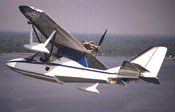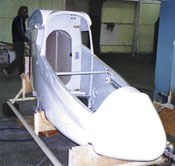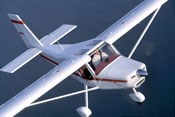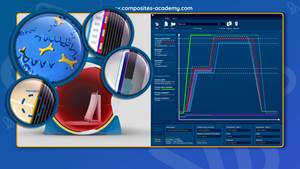Light-sport Plane Category Creates Take-off Point For Composites
Composites manufacturers and suppliers — and pilots — benefit from new FAA aircraft designation.
Share
Until now, those who have bought new recreational aircraft usually have done so in one of two ways — either they've had sufficient disposable income to buy an Federal Aviation Administration (FAA)-certified aircraft, or they've had sufficient time and interest to build one and qualify for an Experimental certificate. Additionally, they've spent a lot of time and money for pilot certification and passed a rigorous medical examination. But the potential market for new personal aircraft could be huge, if the planes were more accessible. According to the General Aviation Manufacturer's Assn. (GAMA, Washington, D.C., U.S.A.), of the estimated 150,000 active single-engine aircraft in the U.S. in 2000, more than 111,000 of them were for personal use. At the height of U.S. general aviation production in 1978, 14,398 single engine aircraft were shipped from U.S. manufacturers. By 1994 — the year that Congress finally passed tort reform to make liability costs tolerable to manufacturers — only 444 single-engine aircraft were shipped from U.S. manufacturers.
Since 1994, U.S. production has been slowly but steadily increasing. In 2000, the best recent year, 1,810 units were shipped. To avoid expensive FAA certification for new designs, many companies simply re-started production of older designs, so many of these aircraft feature sheet-metal technology that is 20 to 30 years old.
The problem is that an aircraft that costs $30,000 per unit to build may cost several million dollars, up front, to certify both the aircraft and its production materials and processes — making the final selling price of a private airplane equivalent to that of a house. The certified Husky A-1B two-seat aircraft by Aviat (Afton, Wyo., U.S.A.), for example, is priced around $142,000. While a ready-to-fly aircraft can be had in the $30,000 range, it won't be new. A quick Internet search revealed a 1984 Cessna 152 available for $24,900 ("Very clean. Runs well. Not burning any oil.") In fact, according to 2002 GAMA statistics, the average age of one-to-three-person, single-engine aircraft in the U.S. is 36 years!
For many years, kit aircraft have filled the affordability and innovation gaps, allowing people to do their own final assembly to meet the FAA's 51 percent owner-built rule under the Experimental Aircraft category, and also enabling manufacturers to avoid expensive type certification while offering aircraft with newer technology. Kit aircraft prices, however, rival the cost of used Cessna 152s, and can take 400 to 3,000 hours to build. Not everyone who wants to fly has the skill, patience — or garage space.
To make flying more accessible, the Experimental Aircraft Assn. (EAA, Oshkosh Wis., U.S.A.) led the lobby for a new aircraft category. After many years, its work is finally paying off. The FAA is in the process of adding the Light-Sport Aircraft (LSA) category, encompassing small, single-engine, two-seat aircraft, gliders, gyroplanes, and powered parachutes.
The EAA list of candidate single-engine aircraft includes existing ultralight aircraft (254 lb maximum aircraft weight), Light-Sport aircraft already certified in other countries, and kit planes that meet the design requirements. It also is intended to legalize the "illegals" — "ultralight" planes that are currently being flown, but exceed the 254-lb weight limit. A three-year phase-in period will bring these aircraft into the new LSA category.
In addition, single-engine planes currently available only as kits may be sold fully assembled and ready to fly under LSA. Instead of an expensive type certificate, an aircraft that conforms to industry and FAA consensus standards for design and fabrication will be issued a special Light-Sport airworthiness certificate. The consensus standards are currently in development by ASTM International's (West Conshohocken, Pa., U.S.A.) Committee F37 on Light-Sport Aircraft, and are scheduled for completion by September 2003.
Kit-built aircraft will undergo an abbreviated inspection and flight test program — similar to that currently required for experimental aircraft — and will be issued an Experimental, Light Sport airworthiness certificate. The primary distinction between owner-built and ready-to-fly, factory-built Light-Sport aircraft will be that only factory built aircraft will be allowed for pilot training and rental.
Relaxed pilot rules (including medical requirements) should increase demand as well. Essentially anyone who has a valid driver's license can earn a Sport Pilot license by taking instruction and passing a written exam. And owner/pilots can maintain their own aircraft after passing a 16-hour course (40 hours for rental maintenance). License restrictions, including daytime-only flight, shouldn't deter recreational pilots.
Based on the FAA's initial proposal, LSA gross weight will be limited to 1,232 lb. This means that the aircraft itself must be as light as possible to maximize the payload, opening up a tremendous opportunity for both aircraft designers and composite suppliers and manufacturers.
Several manufacturers already have strategies in place for lightweight, durable aircraft that will meet LSA requirements. The Canadian Pelican Sport 600 and the Ukrainian A-20 Varlet have composite fuselages and metal wings, and each is now available as a kit in the U.S.
Canadian kit craft
Ultravia Aero (Gatineau, Ontario, Canada) manufactures the Pelican Sport 600 kit, which soon will be available ready-built under the new FAA Light-Sport category. Ultravia engineer and co-owner Jean-René Lepage originally developed the aircraft to meet Canadian and European standards that emerged in the 1990s for Light-Sport aircraft. These standards provide much of the basis for the new U.S. Light-Sport standards. Once the new Sport Plane category becomes official, U.S. buyers will be able to buy the aircraft ready-to-fly or in kit form, or in a variety of levels of pre-assembly, no longer limited by the 51 percent owner-build requirement.
While some sport airplane hulls are basically metal designs that use composites instead of sheet metal, the fuselage of the Pelican Sport 600 was designed as a true composite structure. LePage does his designs primarily on vellum and does preliminary design analysis using self-developed computer codes. He then contracts out material characterization, detailed structural analysis and qualification testing to one of several professional firms to verify his designs.
Ultravia uses a variety of fiberglass and core materials in Pelican aircraft: E-glass, S-glass, PVC foam, balsa wood and aircraft birch plywood. Materials are selected to optimize each area of the fuselage, to minimize both weight and performance variations from one aircraft to another. As a result of careful material selection and manufacturing processes, fuselage weights vary from 77 lb to 81 lb — about ±2.5 percent variation.
Prior to layup, all molds get a light coating of Progress Plastics' (Drummondville, Quebec, Canada) 22X019 gel coat, which stays with the part to eliminate pinholes, minimizing surface preparation prior to paint. The semi-translucent gel coat's low viscosity enables it to be applied in a thin layer, making it possible to visually inspect the laminate.
Where many manufacturers use style 7781 E-glass fabric 295 g/m2 (8.7oz/yd2), Ultravia Aero uses primarily Hexcel (Anderson, S.C., U.S.A.) 4533 S2-glass fabric, with additional unidirectional glass around the posts where extra stiffness is needed. The 191g/m2 (5.6oz/yd2) 4533 is more expensive than E-glass, but the better mechanical properties of the S-2 glass provide a significant weight advantage. S-2 glass fabric is about 15 percent stiffer and more than 50 percent stronger than E-glass, so less material is required. Prices currently posted on Internet sites indicate that the S-2 glass fabric is about three times the cost of E-glass, but well below carbon fabrics (approximately $0.45 ft2 for 7781 E-glass; $1.30/ft2 for 4533 S-2 glass; and $2.65/ft2 for 282 g/m2 plain-weave carbon fabric).
The room-temperature cure resin used for the wet layup of the composite parts is 470-300 vinyl ester from Dow Chemical Co. (Midland, Mich., U.S.A.), selected because its mechanical characteristics are comparable to many room-temperature cure epoxies. Vinyl ester's corrosion- and temperature-resistance and elongation (toughness) make it suitable even for the Pelican's wing fuel tanks. The number of glass layers varies according to the structural needs in different areas. In the cabin landing gear attach area where the highest loads are seen, the laminate is seven layers thick. The mid-tail has single-layer facesheets, with three layers at the back of the tail.
To optimize weight savings and part consistency, the primary core used in sandwich areas is Baltek Corp.'s (Northvale N.J., U.S.A.) Air-Lite 4.5 lb density-controlled, closed-cell PVC core. Baltek cuts AirLite sheets from 3-inch thick Herex C70 buns, which have been bonded into large blocks and then turned 90° and sliced perpendicular to the glue lines similar to butcher-block construction. According to Baltek's Marc Anderson, this approach provides higher yield and greater density control (density varies less than 5 percent, compared with 25 to 30 percent in many PVC core products). The foam core is sealed by a mixture of 3M Engineered Products and Solutions (London, Ontario, Canada) Scotchlite K15 glass bubbles and resin to prevent strength-robbing air bubbles from forming. Holes drilled in the core allow resin to penetrate to increase the bond with the facesheets. In tight-radius areas where the fabric bridges, cotton flock is used to reinforce the resin that fills the radii.
In high-load areas, higher performance structural core materials are used. The cabin is primarily Baltek's density-controlled rigid end-grain balsa. Birch plywood is used to reinforce primary structural attach points in the nose section firewall and pedal attach points, the cabin floor and the bracket attach points for the carry-through tube that carries wing loads across the top of the cabin, as well as in the tail where the stabilizer attaches.
The layup sequence is as follows: a very thin coat of gel coat is applied to the mold; the outside fabric is applied and impregnated with resin; the cores are placed and spread with the resin/glass bubble mixture. The assembly is vacuum bagged and cured for four to six hours. The bag is removed and the inner skins are layed up and then the cure cycle is repeated. Ultravia is currently experimenting with resin infusion methods.
The temperature-limiting component of the Pelican design is the foam core, which can soften under high temperatures. The glass transition temperature (Tg) of all components is critical and a rule of thumb is to keep the Tg of all materials at least 10°C/50°F higher than the maximum in-service temperature. Owners are virtually always advised to paint their aircraft a light color to reflect heat away.
The geometry of some of the Pelican pieces, such as the lower cowling and wing tips, lends sufficient rigidity so that a solid laminate is used and no core is necessary. The upper cowling is flat, however, so it includes a layer of PVC core to increase rigidity.
Ultravia makes all its molds in-house, and uses an AXYZ Automation 4008 CNC cutting table (Burlington, Ontario, Canada) to produce accurate patterns, supplemented by hand finishing to perfect the geometry of the "plug" or master model of the part. Large tools are fitted with welded steel understructure and wheels, and smaller tools are on a box suitable for tabletop layup.
To meet inspection criteria for a variety of international standards, including anticipated FAA Light-Sport consensus standards, Ultravia has implemented a traceability system that records the lot numbers of all materials used in the fabrication of each part (resin, additives, fiberglass, cores, etc.). Each part is inspected for conformity to the production drawing. The quality system was developed to meet requirements for Transport Canada.
LSA plane from the Ukraine
John Hunter of Spectrum Aircraft (Sebring, Fla., U.S.A.) is enthusiastic about the A-20 Varlet aircraft — the latest in the A-20 line of aircraft from Ukrainian company Aeroprakt. "The A-20 Varlet is a new model, developed specifically for the new LSA market," says Hunter. "It is a refinement of the A-20 Vista line of sport planes, first introduced by Spectrum in 2000." The first A-20 Varlet kits arrived at Spectrum in late February 2003. As of early 2003, approximately 40 A-20 Vistas (including the STOL, SS and Cruiser A-20 models) were in the air.
"The original A-20 was the result of an effort on the part of a team of aeronautical engineers at Antonov, the industrial giant and producer of commercial transport jets from the Ukraine. The Antonov team formed a club called "Aeroprakt," meaning "the practical application of aeronautical science to sports planes."
Unveiled in 1991, the A-20 was so successful, winning awards in competition in Europe, that the principal club members Oleg Litovchenko and Yuri Yakovlev, formed a rapidly growing private commercial enterprise. Along with seven additional former Antonov engineers they have produced six different types of sport aircraft, including all of the A-20s (and A-30), the tractor (engine in front) A-22, the Amphibian A-24, and the twin-engine A-26, A-28 and A-36. To date Aeroprakt has delivered close to 100 aircraft.
"The A-20 Varlet design was optimized specifically to meet the new LSA specifications for the U.S. market," Hunter says. It differs from the rest of the A-20 line in several respects. Its cantilevered wing (no struts) of reduced span meets the lower LSA speed requirements and also results in lower aerodynamic drag and a faster roll rate, making the Varlet one of the "sportiest" entries in the new class. Low takeoff and landing speeds are safety features and give the Varlet short- and/or rough-field capability (STOL), which gives the Varlet access to "ultralight" grass fields. "At the same time, it has a higher cruising speed than a Cessna 152, by 20 mph," Hunter maintains.
While design details are sketchy, the Varlet incorporates a composite fuselage pod, engine cowl, wing tips and wheel pants, while wings and control surfaces are aluminum, covered in part by aircraft fabric to reduce weight. Its hand layed-up all-composite hull is fiberglass/epoxy over Airex foam core, layed up in two halves and spliced together in a secondary operation. Core edge sealing is not an issue for Aeroprakt because their laminates are designed to completely trap the core. Transitions from sandwich to coreless laminates are made by increasing the number of plies as the core thickness decreases
Most of the glass is T-10-14, an Eastern European 8-harness satin weave E-glass fabric similar to style 7781. E-glass was selected because it is inexpensive and easy to obtain. Yakolev says, "Mostly, our composite structures are not highly loaded, so there is no need to use more expensive, high-strength materials." Epoxy resin was chosen for its low coefficient of thermal expansion, which translates into less shrinkage and potential warping in larger parts. Epoxies used are ED-20 (Ufa, Russia) and Lang und Ritter (Gerlingen, Germany), cured under vacuum at 71°C/160°F. No gel coat is used because it adds weight equivalent to an extra ply of material. Instead the hull is sanded and painted after cure.
Aeroprakt makes mold plugs from Sika Corp.'s (Baar, Switzerland) machined block materials and molds from fiberglass/epoxy covered with Lang und Ritter's Larit 225 tooling gel coat. The company generally gets about 100 parts off of a mold.
The A-20 also features a composite propeller. Designed with a metal leading edge for erosion control, the propeller is manufactured in a single autoclave cure cycle.
A 98 percent pre-built Varlet kit sells for $48,000. The sporty, two-seat composite airplane can be ready to fly after only 40 hours of finishing work.
U.S. manufacturers step up
Several U.S. manufacturers are gearing up to produce kit or fully assembled aircraft for the new Light-Sport category. Progressive Aerodyne (Orlando, Fla., U.S.A.) manufactures the two-passenger amphibious SeaRey. Its strategy has been to subcontract the manufacture of the composite hulls to composite specialty shops. The heavier fiberglass hulls are made by STM Industries (Oldsmar, Fla., U.S.A.). To meet the weight and performance requirements of the Light-Sport category, Progressive has contracted with Carbon Fiber Manufacturing (CFM, Fort Mill, S.C., U.S.A.) to make a carbon/epoxy and PVC foam core hull. CFM owner Kenny Farrell was a commercial A&P mechanic before a combined interest in racecars and composites led him to open a composite fabricating shop. For the SeaRey hull, CFM uses a 195g/m2 plain-weave carbon fabric from Hexcel, impregnated with laminating epoxy from Gougeon Brothers (Bay City, Mich., U.S.A.). After gel coat is applied, outer plies are layed up and allowed to A-stage cure overnight at room temperature. (Unlike Ultravia, which cocures the Pelican's sealed core concurrently with the outer facesheets, CFM cures the outer facesheets separately.) The next day, DIAB Americas LP's (DeSoto, Texas, U.S.A.] Klegecell PVC core and the inner plies are installed. The entire assembly is vacuum bagged and post-cured in an oven at 82°C/180°F for eight hours.
High on Farrell's product wish list is a gel coat designed specifically to work with epoxy laminating resins. "We haven't found an epoxy-based gel coat, and the vinyl ester gel coat we use is marginal with the epoxy." In addition, Farrell is experimenting with resin infusion. "We are making some progress," he notes, but adds, "We have had to put quite a bit of expense into trial and error. We hope that it will pay off in the long run."
ComposiCraft, a startup company based in Colorado Springs, Colo., U.S.A., is designing a composite aircraft for the Light-Sport category from the ground up. While most design details remain under wraps, ComposiCraft president Paul Klahn had this to say: "The Sport Pilot rule really has the potential to bring general aviation back to life, and to pull it into the 21st century. We'll have the opportunity to manufacture a modern airplane and sell it at a reasonable price — competitive with the higher-end SUV's and other recreational vehicles."
Klahn envisions the turning point for small aircraft manufacturers will be when they are able to consistently produce high-quality aircraft in large volumes. "People are well aware of all the innovations going on in resin transfer molding, vacuum infusion, new tooling products, and so on," he says. "This is where we're headed. We've got a great airplane concept, and people are going to love it. Better yet, we've got a great manufacturing strategy, so we'll be able to deliver a quality product to the customer in a timely manner."
Klahn also expects high demand for new light-sport aircraft: "There's no doubt it will justify our initial expense of production tooling and equipment."
Related Content
NASA names university teams for aeronautics research challenges
As part of the agency’s University Leadership Initiative, three multidisciplinary teams will address topics related to growth in AAM, while a fourth examines electricity generation for future airliners.
Read MoreAMRC Training Centre introduces composites apprenticeship opportunity
With partners McLaren and Teledyne CML Composites, the Training Center will train new composites technicians in South Yorkshire to build up the future industry workforce.
Read MoreBelzona opens fifth European SuperWrap Training Centre
Global training facilities provide intensive, first-class installer and supervisor training for proper use and application of Belzona composite pipe and tank repair systems.
Read MoreNew online training course targets prepreg basics
JEC World 2024: Composites Expert highlights how its E-Learning Composites Academy platform supports flexible industry learning with new courses developed with Stelia Aerospace North America.
Read MoreRead Next
Developing bonded composite repair for ships, offshore units
Bureau Veritas and industry partners issue guidelines and pave the way for certification via StrengthBond Offshore project.
Read MorePlant tour: Daher Shap’in TechCenter and composites production plant, Saint-Aignan-de-Grandlieu, France
Co-located R&D and production advance OOA thermosets, thermoplastics, welding, recycling and digital technologies for faster processing and certification of lighter, more sustainable composites.
Read MoreAll-recycled, needle-punched nonwoven CFRP slashes carbon footprint of Formula 2 seat
Dallara and Tenowo collaborate to produce a race-ready Formula 2 seat using recycled carbon fiber, reducing CO2 emissions by 97.5% compared to virgin materials.
Read More
























